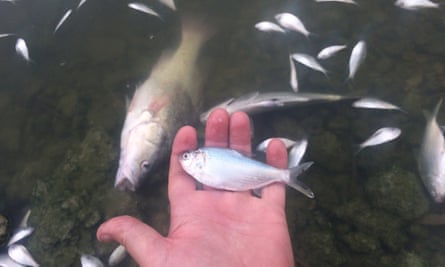A third fish kill has occurred near Menindee on the Darling River overnight after temperatures plummeted following days of hot weather.
The latest fish kill follows an incident on 6 and 7 January in which hundreds of thousands of native fish, including Murray cod, golden perch and bony bream died around the Menindee weir.
There was also another mass kill before Christmas.
“This is likely worse than the last time,” said local Graeme McCrabb, who on Monday morning was down at the water’s edge at the back of the township, above Weir 32.
“I’ve just picked up a 50cm golden perch, and there are tens of thousands of little bony bream, dead.
“There are fish all around me just gasping for breath,” he said.
McCrabb said he had not spotted any Murray cod, which can grow to a metre and be up to 40 or 50 years old. But he said that during the previous fish kill the Murray cod had been the last to surface.

Menindee tourism operator Rob Gregory told Guardian Australia he could see thousands of dead fish on Monday morning.
“We’re down on the edge now and there’s quite a lot of fish dying in front of us at the moment,” he said.
Gregory said there had been a couple of cooler days in the area, and the fish may have died on Sunday, sunk to the bottom of the river and then floated up on Monday.
“It’s a tragedy, we’re seeing the fish that are the only ones left that are dying now. It’s certainly disheartening there’s no doubt about it,” he said.
This article includes content provided by Facebook. We ask for your permission before anything is loaded, as they may be using cookies and other technologies. To view this content, click 'Allow and continue'.
Gregory urged the New South Wales premier, Gladys Berejiklian, and the prime minister, Scott Morrison, to sort out the management of the basin.
“Today is the day they need to get on a plane here and have a look for themselves what mismanagement is doing,” he said.
Berejiklian suggested the mass kill could not have been avoided, saying “we cannot control the weather”.
“Under the current circumstances, if we could have avoided it we will,” she told reporters in Sydney.
“I was advised the sudden drop in temperature makes it conducive, unfortunately, for the fish to be deprived of oxygen.”

The federal Labor leader, Bill Shorten, said the Murray-Darling was “facing the makings of an ecological disaster”.
“This is not standard, this is not normal. This is a disaster,” he told reporters in Melbourne.
NSW regional water minister Niall Blair said aerators had been installed between the fish kill events but it was difficult to prevent.
“Unfortunately though we’re expecting the conditions to potentially continue to deteriorate,” he told reporters in Sydney.
He said there have also been reports of trout deaths in the Thredbo River.
Blair defended his state government’s water release management practices and said he’s looking to head out to the area as soon as possible.
An interim investigation by the New South Wales Department of Primary Industries, released last week, found the previous deaths were likely to have been caused by “several related and compounding factors resulting in low oxygen in the river”.
The report also confirmed the second incident on 6 January involved the “unprecedented” death of “hundreds of thousands of fish”.
The report blamed “thermal stratification in which a warmer surface layer of about one metre of water sat above a cooler deeper layer (2-3m) of water with very low dissolved oxygen”.
“These conditions were conducive to blue-green algal blooms in the surface layers,” it said.
“Another substantial drop in air temperatures from 46C to 28C on January 4 and 5 associated with cold fronts passing through the region again caused layers of water with different dissolved oxygen levels to mix, reducing the overall dissolved oxygen available,” the report said.
There was also a release from Pamamaroo Lake which is thought to have put high salt levels into the river.
Locals had feared fluctuations in water temperature could trigger another fish kill.
Menindee has been sweltering under temperatures above 40C. There has been little or no flow in the Darling River, due to the extended drought conditions.
McCrabb said the Department of Primary Industries staff had left, as had the clean-up crew sent in to deal with the earlier fish kill.
On Monday morning a Department of Primary Industry spokeswoman said fisheries officers were en route to assess the situation in the Menindee weir pool and neighbouring sections of the Darling River.
“[The fish kill] is likely linked to some rain and cooler temperatures in the Menindee area following an extended period of very hot weather,” the spokeswoman said.
Comments (…)
Sign in or create your Guardian account to join the discussion